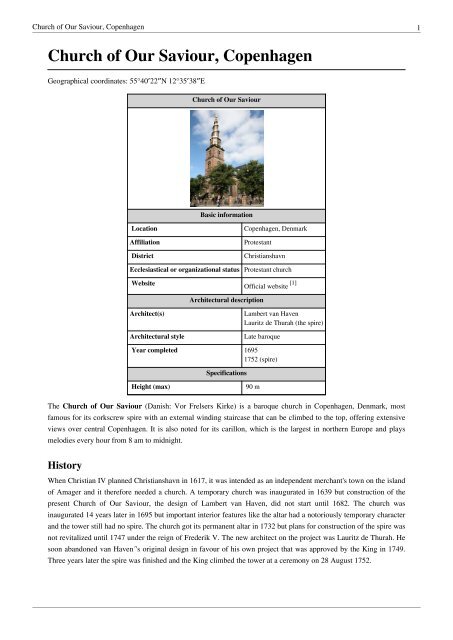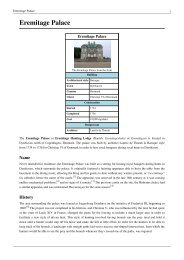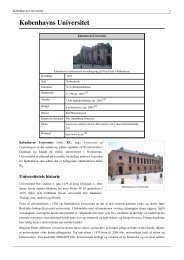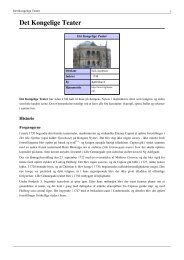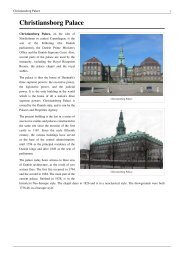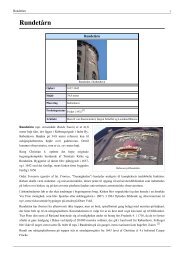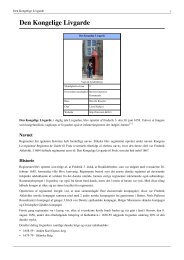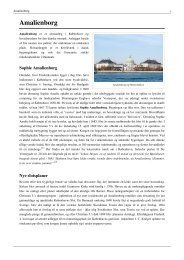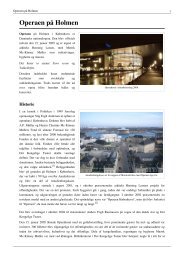Church of Our Saviour, Copenhagen
Church of Our Saviour, Copenhagen
Church of Our Saviour, Copenhagen
You also want an ePaper? Increase the reach of your titles
YUMPU automatically turns print PDFs into web optimized ePapers that Google loves.
<strong>Church</strong> <strong>of</strong> <strong>Our</strong> <strong>Saviour</strong>, <strong>Copenhagen</strong> 1<br />
<strong>Church</strong> <strong>of</strong> <strong>Our</strong> <strong>Saviour</strong>, <strong>Copenhagen</strong><br />
Geographical coordinates: 55°40′22″N 12°35′38″E<br />
<strong>Church</strong> <strong>of</strong> <strong>Our</strong> <strong>Saviour</strong><br />
Basic information<br />
Location <strong>Copenhagen</strong>, Denmark<br />
Affiliation Protestant<br />
District Christianshavn<br />
Ecclesiastical or organizational status Protestant church<br />
Website<br />
Architectural description<br />
Official website [1]<br />
Architect(s) Lambert van Haven<br />
Lauritz de Thurah (the spire)<br />
Architectural style Late baroque<br />
Year completed 1695<br />
1752 (spire)<br />
Specifications<br />
Height (max) 90 m<br />
The <strong>Church</strong> <strong>of</strong> <strong>Our</strong> <strong>Saviour</strong> (Danish: Vor Frelsers Kirke) is a baroque church in <strong>Copenhagen</strong>, Denmark, most<br />
famous for its corkscrew spire with an external winding staircase that can be climbed to the top, <strong>of</strong>fering extensive<br />
views over central <strong>Copenhagen</strong>. It is also noted for its carillon, which is the largest in northern Europe and plays<br />
melodies every hour from 8 am to midnight.<br />
History<br />
When Christian IV planned Christianshavn in 1617, it was intended as an independent merchant's town on the island<br />
<strong>of</strong> Amager and it therefore needed a church. A temporary church was inaugurated in 1639 but construction <strong>of</strong> the<br />
present <strong>Church</strong> <strong>of</strong> <strong>Our</strong> <strong>Saviour</strong>, the design <strong>of</strong> Lambert van Haven, did not start until 1682. The church was<br />
inaugurated 14 years later in 1695 but important interior features like the altar had a notoriously temporary character<br />
and the tower still had no spire. The church got its permanent altar in 1732 but plans for construction <strong>of</strong> the spire was<br />
not revitalized until 1747 under the reign <strong>of</strong> Frederik V. The new architect on the project was Lauritz de Thurah. He<br />
soon abandoned van Haven´'s original design in favour <strong>of</strong> his own project that was approved by the King in 1749.<br />
Three years later the spire was finished and the King climbed the tower at a ceremony on 28 August 1752.
<strong>Church</strong> <strong>of</strong> <strong>Our</strong> <strong>Saviour</strong>, <strong>Copenhagen</strong> 2<br />
Urban legend<br />
There is a long-lived urban legend stating that the architect killed himself by jumping from the top <strong>of</strong> the spire, when<br />
he realised that the spiral turns the wrong way - anticlockwise - around. This is not about Lambert van Haven, since<br />
the spire was added to the church almost 50 years after his death, but the designer <strong>of</strong> the spiral spire, Laurids de<br />
Thurah. There is not a grain <strong>of</strong> truth in the myth though, since Thurah died in his bed seven years after the spire was<br />
completed, and there is nothing in the records that indicates that he should have been unhappy with his work in any<br />
way.<br />
Architecture<br />
The church is built in a Dutch baroque style and its basic layout is a Greek cross. The walls rest on a granite<br />
foundation and are made <strong>of</strong> red and yellow tiles but in a random pattern unlike what is seen in Christian IV's<br />
buildings where they are generally systematically arranged. The facade is segmented by pilasters in the Palladin<br />
giant order, that is they continue in the building's entire height. The pilasters are <strong>of</strong> the Tuscan order with bases and<br />
capitals in sandstone. The cornice is also in sandstone but with a frieze in tiles. Between the pilasters are tall<br />
round-arched windows with clear glass and iron cames. There are entrances at the gable <strong>of</strong> the cross arms except for<br />
the eastern gable where the sacristy is added. The main entrance is in the western gable below the tower and has a<br />
sandstone portal. All entrances are raised four steps from street level. At each side <strong>of</strong> the tower, there is a gate at<br />
street level leading to the two crypts <strong>of</strong> the church. The ro<strong>of</strong> is vaulted and covered in black-glazed tiles.<br />
Tessins's altarpiece<br />
The altarpiece is the work <strong>of</strong> Nicodemus Tessins and is considered a masterpiece. It<br />
depicts a scene from the Garden <strong>of</strong> Gethsemane between two columns, where Jesus<br />
is comforted by an angel while another angel hangs in the air beside them, carrying<br />
the golden chalice. On each side, two figures <strong>of</strong> Pietas and Justitia illustrate the<br />
King's motto. The two columns carry a broken, curved architrave and gable. Behind<br />
the opening <strong>of</strong> the broken gable is placed a pane with Jahve's name in Hebrew<br />
inscribed and lit from behind. Around the pane is an arrangement <strong>of</strong> gilded beans<br />
and cloud formations.<br />
Organ<br />
The huge pretentious organ with Christian V’s gilded monogram was built by the<br />
Botzen Brothers from 1698-1700 and is mounted on the wall and supported by two<br />
elephants. The organ has more than 4000 pipes with the original cymbelstern<br />
tinkling in the background during a special part <strong>of</strong> a music piece, and the entire<br />
instrument produces the sound that was heard in the church over 300 years ago. The<br />
church arranges 15-20 concerts every year together with musical church services on<br />
Sundays. The last rebuilding <strong>of</strong> the organ was in 1965, reusing older pipe work and<br />
Tessin's altarpiece<br />
OrgelThe organ facade
<strong>Church</strong> <strong>of</strong> <strong>Our</strong> <strong>Saviour</strong>, <strong>Copenhagen</strong> 3<br />
this instrument is equipped with 57 stops spread over 4 manuals and pedals. The facade <strong>of</strong> the organ has intricate<br />
wood carvings and a bust <strong>of</strong> Christian V in the centre.<br />
Tower<br />
The tower is raised three stories above the western cross arm. The levels are marked by sandstone cornices that<br />
become larger with height, and there are round-arched openings on all four sides at each level. The top level is<br />
decorated with flat pilasters and from the uppermost cornice has a gilded penetrated clock face centrally on each<br />
side. The hands are connected to a clockwork inside the tower.<br />
Spire<br />
The black and golden spire reaches a height <strong>of</strong> 90 metres and the external staircase<br />
turns four times anticlockwise around it. Inspiration for the design came from the<br />
spiral lantern <strong>of</strong> Sant'Ivo alla Sapienza, which turns the same way around.<br />
It is built as a timber-framed structure, octagonall at its base, with round-arched<br />
openings and round windows with gilded frames. The windows are flanked by<br />
gilded pilasters in the composite order. Around the octagonal base <strong>of</strong> the spire, on<br />
the four corners <strong>of</strong> the square tower, stand four statues <strong>of</strong> the four evangelists. The<br />
octagonal structure is topped by a small platform with a gilded railing and it is from<br />
this point that the staircase become external. There is a total number <strong>of</strong> 400 steps to<br />
the top <strong>of</strong> the spire, the last 150 being outside.<br />
The spire is topped by a vase-like structure, carrying a gilded globe with a<br />
4-meter-tall figure, carrying a banner. It has an infamous reputation for being the<br />
ugliest sculpture in <strong>Copenhagen</strong> but is intentionally made with exaggerated<br />
proportions because it is only meant to be seen from long distances.<br />
Carillon<br />
Thurah's corkscrew spire<br />
The tower <strong>of</strong> the church is equipped with a concert carillon from 1928 that was rebuilt in 1980 and consists <strong>of</strong> 48<br />
bronze carillon bells that have a musical range <strong>of</strong> four octaves, which makes it the largest carillon system in North<br />
Europe. The largest bells weigh over 2,000 kilo and the smallest 10 kilos. Totally the Carillon instrument weighs<br />
almost 12 tonnes and chimes every hour over Christianshavn with different hymn compositions.<br />
Cultural connections<br />
The <strong>Church</strong> <strong>of</strong> <strong>Our</strong> <strong>Saviour</strong> in Christianshavn appears in a chapter <strong>of</strong> Jules Verne's A Journey to the Center <strong>of</strong> the<br />
Earth. The character Axel is made to climb the winding spire for five consecutive days by his uncle to cure him <strong>of</strong><br />
his Acrophobia before their descent into the volcano. [2]<br />
The French painter and illustrator Édouard Riou has depicted the church in the original French illustrated version <strong>of</strong><br />
A Journey to the Center <strong>of</strong> the Earth, but has the spire turned the wrong way around, that is, clockwise instead <strong>of</strong><br />
anitclockwise. [3]
<strong>Church</strong> <strong>of</strong> <strong>Our</strong> <strong>Saviour</strong>, <strong>Copenhagen</strong> 4<br />
External links<br />
• Vor Frelsers Kirke [1] <strong>of</strong>ficial website<br />
• Vor Frelsers Kirke [4] map<br />
References<br />
[1] http:/ / www. vorfrelserskirke. dk/<br />
[2] "Jules Verne in <strong>Copenhagen</strong>." (http:/ / www. jules-verne. dk/ copenhagen. html). The Danish Jules Verne Society newsletter no. 1.. .<br />
Retrieved 2009-04-26.<br />
[3] "Højdeskræk - Jules Verne og Vor Frelsers kirkes spir." (http:/ / www. jules-verne. dk/ vorfrelsersspir. html). The Danish Jules Verne Society<br />
newsletter no. 1.. . Retrieved 2009-04-26.<br />
[4] http:/ / maps. google. com/ maps?ll=55. 672778,12. 593889& q=55. 672778,12. 593889%20(Vor%20Frelsers%20Kirke)
Article Sources and Contributors 5<br />
Article Sources and Contributors<br />
<strong>Church</strong> <strong>of</strong> <strong>Our</strong> <strong>Saviour</strong>, <strong>Copenhagen</strong> Source: http://en.wikipedia.org/w/index.php?oldid=352786027 Contributors: 1oddbins1, Beard0, Brick Thrower, Bunnyhop11, Carewolf, Chris the<br />
speller, Clariosophic, Danny, Esowteric, Heart<strong>of</strong>aDog, Hemmingsen, IbRas, Ipigott, JaGa, JimVC3, Keithh, Kettel, Klausok, LOL, Lilac Soul, Maltelunden, Mild Bill Hiccup, Mimihitam,<br />
Palladion, Physicistjedi, PigFlu Oink, Ramblersen, Rjwilmsi, Rosiestep, Sunquanliangxiuhao, Thue, Tikiwont, Tomas417, Valentinian, Welsh, 25 anonymous edits<br />
Image Sources, Licenses and Contributors<br />
File:Vor Frelsers Kirke <strong>Copenhagen</strong> 2.jpg Source: http://en.wikipedia.org/w/index.php?title=File:Vor_Frelsers_Kirke_<strong>Copenhagen</strong>_2.jpg License: Public Domain Contributors: Ib<br />
Rasmussen<br />
Image:Vor Frelsers Kirke <strong>Copenhagen</strong> altar.jpg Source: http://en.wikipedia.org/w/index.php?title=File:Vor_Frelsers_Kirke_<strong>Copenhagen</strong>_altar.jpg License: Public Domain Contributors: Ib<br />
Rasmussen<br />
Image:Vor Frelsers Kirke <strong>Copenhagen</strong> organ.jpg Source: http://en.wikipedia.org/w/index.php?title=File:Vor_Frelsers_Kirke_<strong>Copenhagen</strong>_organ.jpg License: Public Domain Contributors:<br />
Ib Rasmussen<br />
Image:Vor Frelsers Kirke <strong>Copenhagen</strong> spire.jpg Source: http://en.wikipedia.org/w/index.php?title=File:Vor_Frelsers_Kirke_<strong>Copenhagen</strong>_spire.jpg License: Public Domain Contributors: Ib<br />
Rasmussen<br />
License<br />
Creative Commons Attribution-Share Alike 3.0 Unported<br />
http:/ / creativecommons. org/ licenses/ by-sa/ 3. 0/


